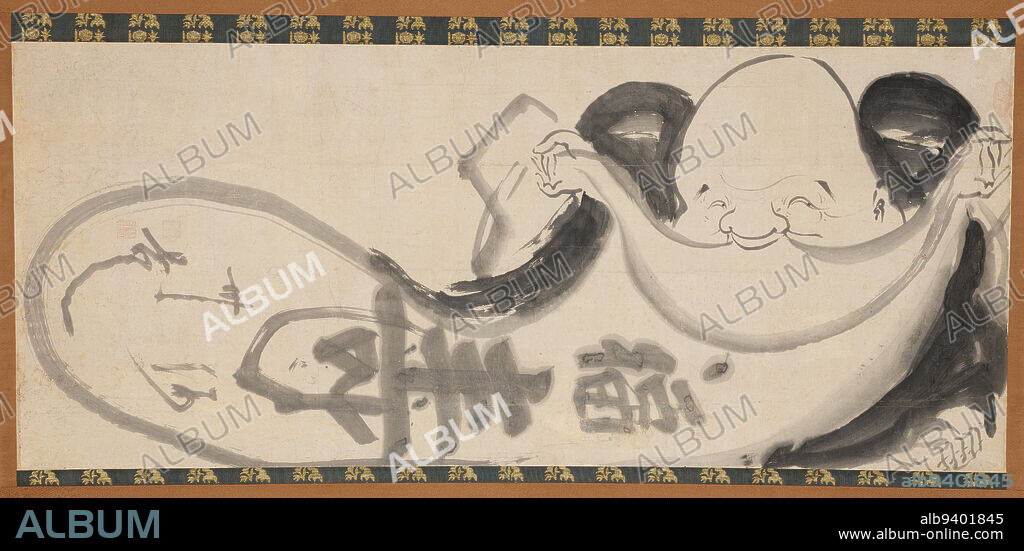alb9401845
Budai Opening His Sack, mid 18th century, Hakuin Ekaku, Japanese, 1685 - 1769, 21 3/4 × 50 15/16 in. (55.25 × 129.38 cm) (image)59 × 53 1/2 in. (149.86 × 135.89 cm) (without roller), Ink on paper, Japan, 18th century, Hakuin Ekaku (16851769), a Zen priest and prolific amateur painter, is credited with reviving the Rinzai sect of Japanese Zen Buddhism after a long period of decline. Hakuin focused on meditation and paradoxical anecdotes or dialogues called kan, the contemplation of which may lead to spontaneous awakening. Hakuins bold, sometimes humorous, and altogether unprecedented paintings were an important vehicle for his teachings, which spread far beyond the monasteries and captured the minds of laypeople. This painting represents one of Hakuins unique and humorous takes on the popular Buddhist figure called Budai, an eccentric wandering monk who is nearly always shown carrying a large cloth sack that holds all of his belongings. Here, he holds the big cloth sack open for us, begging us to peer inside. An inscription, brushed sideways on the sack, reads, 'Life and happiness are as endless as the sea.

|
Añadir a otro lightbox |
|
Añadir a otro lightbox |



¿Ya tienes cuenta? Iniciar sesión
¿No tienes cuenta? Regístrate
Compra esta imagen.
Selecciona el uso:

Descripción:
Ver traducción automática
Budai Opening His Sack, mid 18th century, Hakuin Ekaku, Japanese, 1685 - 1769, 21 3/4 × 50 15/16 in. (55.25 × 129.38 cm) (image)59 × 53 1/2 in. (149.86 × 135.89 cm) (without roller), Ink on paper, Japan, 18th century, Hakuin Ekaku (16851769), a Zen priest and prolific amateur painter, is credited with reviving the Rinzai sect of Japanese Zen Buddhism after a long period of decline. Hakuin focused on meditation and paradoxical anecdotes or dialogues called kan, the contemplation of which may lead to spontaneous awakening. Hakuins bold, sometimes humorous, and altogether unprecedented paintings were an important vehicle for his teachings, which spread far beyond the monasteries and captured the minds of laypeople. This painting represents one of Hakuins unique and humorous takes on the popular Buddhist figure called Budai, an eccentric wandering monk who is nearly always shown carrying a large cloth sack that holds all of his belongings. Here, he holds the big cloth sack open for us, begging us to peer inside. An inscription, brushed sideways on the sack, reads, 'Life and happiness are as endless as the sea.
Personas:
Crédito:
Album / quintlox
Autorizaciones:
Tamaño imagen:
8400 x 4083 px | 98.1 MB
Tamaño impresión:
71.1 x 34.6 cm | 28.0 x 13.6 in (300 dpi)
Palabras clave:
ABADIA • ACREDITADO • ALEGRIA • CAPTURADO • CLAUSTRO • CONTEMPLACION • DIRIGIR • FELICIDAD • FLOTA • HAKUIN EKAKU • IMAGEN • INSCRIPCION • JAPON • JAPONES • MAR • MARINA • MARINE • MEDITACION • MONASTERIO • MONASTERIOS • OCEANO • RULOS • S. XVIII • SACO • SEA • SIGLO XVIII • SIN FIN • TINTA SOBRE PAPEL • VIDA


 Pinterest
Pinterest Twitter
Twitter Facebook
Facebook Copiar enlace
Copiar enlace Email
Email
